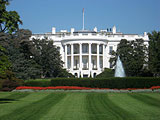Plus Ça Change: The Middle East
By Roland Popp for ISN
Amid widespread speculation, the likely direction of the Obama administration's Middle East approach is beginning to take shape. Secretary of State Hillary Clinton's trip to the region gave some clues with respect to potential continuities and possible departures in comparison to US policies during the Bush years.
Those who were hoping for radical change in the US peacemaking approach to the Arab-Israeli conflict certainly will have been disappointed by the first impression created by Clinton's performance at the Sharm al-Sheikh conference on humanitarian assistance in the aftermath of the Israeli assault on Gaza. In addressing Palestinian President Mahmoud Abbas and Prime Minister Salam Fayyad as 'our Palestinian partners,' her public remarks conspicuously resembled those of her predecessor Condoleezza Rice.
Many observers from the region were quick in inferring a continuation of the "West Bank First" strategy followed by the US in previous years – shoring up the "moderate" Fatah leadership in Ramallah while isolating the Hamas – despite the obvious failure of this policy demonstrated by the growing popularity of the Hamas movement among Palestinians and its evermore entrenched control of the Gaza Strip.
This impression was reinforced by the fact that of the US$900 million pledged by the US during the conference, two thirds are earmarked for the Fatah-controlled Palestinian Authority in Ramallah. This hardly signals a dominance of humanitarian concern for the plight of the population in Gaza on the part of the American donors.
The conditions for US acceptance of a future Palestinian unity government, laid down repeatedly by then-presidential candidate Barack Obama during his election campaign and by Clinton since taking office, aim in the same direction. A Fatah-Hamas government would only be acceptable if the Islamist organization met the demands of the Middle East Quartet, i.e. renunciation of violence, acceptance of all previous agreements and recognition of Israel.
Knowing full well that these conditions are unacceptable for Hamas, it seems the Obama administration will stick to the policy of diplomatic isolation of the Gaza government.
It may be nonetheless premature to regard the Obama approach to peacemaking as a continuation of its predecessor's policies. An alternative reading of recent developments stresses the actual loopholes left in public statements. In fact, the US position might be much less rigid than it seems at first glance.
In fact, the position does not rule out a future Palestinian unity government altogether. Egyptian mediation efforts currently underway aim at the creation of a technocratic caretaker government supported by the rival factions. Such a government could accept the Quartet principles without forcing conditions on Hamas, which it would see as tantamount to capitulation.
Another idea for reconciliation is to incorporate Hamas into the Palestine Liberation Organization (PLO), the traditional umbrella organization of the Palestinian national movement. This might open up the chance to gradually move the Islamist organization toward a more moderate stance, including acceptance of Israel "as a reality" as some Hamas leaders have hinted at in the past, albeit less than recognizing its right of existence.
Applying this, admittedly rather scholastic, stance sketched above together with the "outsourcing" of actual negotiations with Hamas to regional and, perhaps, European mediators for indirect talks with the group might provide a chance to bypass the rigid enforcement of the Quartet principles and, hence, to avoid the undermining of reconciliation efforts as had happened before in 2007.
It would also help to deflect, or at least dampen, domestic criticism in the US, foremost congressional attitudes against any kind of contact with "terrorist organizations."
There's another indication which hints against the continuance of the isolation tactic: Obama's special envoy for the Middle East, George Mitchell, had faced a similar problem when mediating during the 1990s in Northern Ireland. Back then, he chose to negotiate with groups which had not renounced the use of violence beforehand in order to achieve peace. He may well choose to follow a similar path in the case of the Palestine conflict.
At this stage, the results of Clinton's first trip to the Middle East are ambiguous. As to be expected, she reaffirmed the close and special relationship with Israel in Jerusalem and reaffirmed US support for a two-state solution to the conflict in Ramallah.
It remains to be seen whether there is any substantial change in US policies toward the Arab-Israeli conflict. As things stand now, however, it is rather unlikely that the Obama administration will resume its predecessors' attempts to disengage as much as possible.
Outside observers point toward subtle changes in policy rhetoric such as Clinton's strong criticism of Israeli blockage of humanitarian goods for Gaza and of the demolition of Palestinian homes.
Furthermore, administration officials repeatedly emphasize that the different regional crisis spots are interconnected. Only an integrated approach linking the trouble spots, symbolized by the naming of special envoys to the Middle East and South Asia, will have a chance for success. Against this background, another sustained effort at peacemaking in the Arab-Israeli conflict seems to be unavoidable.
Given these wider strategic preoccupations and its resulting necessities for progress on Arab-Israeli conflict resolution together with the prospect of a right-wing government hostile even to the idea of a Palestinian state taking office in Jerusalem, future policy clashes between the US and Israel seem likely.
